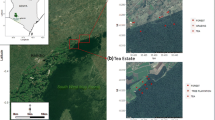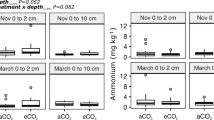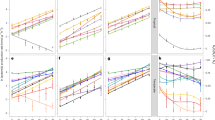Abstract
Background and aims
Approximately 50 % of belowground organic carbon is present in the northern permafrost region and due to changes in climate there are concerns that this carbon will be rapidly released to the atmosphere. The release of carbon in arctic soils is thought to be intimately linked to the N cycle through the N cycle’s influence on microbial activity. The majority of new N input into arctic systems occurs through N2-fixation; therefore, N2-fixation may be the key driver of greenhouse gases from these ecosystems.
Methods
At Alexandra Fjord lowland, Ellesmere Island, Canada concurrent measurements of N2-fixation, N mineralization and nitrification rates, dissolved organic soil N (DON) and C, inorganic soil N and surface greenhouse gas fluxes (CO2, N2O and CH4) were taken in two ecosystem types (Wet Sedge Meadow and Dryas Heath) over the 2009 growing season (June-August). Using Structural Equation Modelling we evaluated the hypothesis that CO2, CH4 and N2O flux are linked to N2-fixation via the N cycle.
Results
The soil N cycle was linked to CO2 flux in the Dryas Heath ecosystem via DON concentrations, but there was no link between the soil N cycle and CO2 flux in the Wet Sedge Meadow. Methane flux was also not linked to the soil N cycle, nor surface soil temperature or moisture in either ecosystem. The soil N cycle was closely linked to N2O emissions but via nitrification in the Wet Sedge Meadow and inorganic N in the Dryas Heath, indicating the important role of nitrification in net N2O flux from arctic ecosystems.
Conclusions
Our results should be interpreted with caution given the high variability in both the rates of the N cycling processes and greenhouse gas flux found in both ecosystems over the growing season. However, while N2-fixation and other N cycling processes may play a more limited role in instantaneous CO2 emissions, these processes clearly play an important role in controlling N2O emissions.




Similar content being viewed by others
References
Adams DG, Duggan PS (1999) Heterocyst and akinete differentiation in cyanobacteria. New Phyto 144:1–33
Arndal MF, Illeris L, Michelsen A, Albert K, Tamstorf M, Hansen BU (2009) Seasonal variation in gross ecosystem production, plant biomass, and carbon and nitrogen pools in five high arctic vegetation types. Arct Antarct Alp Res 41:164–173
Barsdate RJ, Alexander V (1975) The nitrogen balance of arctic tundra: pathways, rates and environmental implications. J Environ Qual 4:111–117
Bazely DR, Jefferies RL (1989) Lesser snow geese and the nitrogen economy of a grazed salt-marsh. J Ecol 77:24–34
Bedard-Haughn A, Tate KW, van Kessel C (2004) Using nitrogen-15 to quantify vegetative buffer effectiveness for sequestering nitrogen in runoff. J Environ Qual 33:2252–2262
Bedard-Haughn A, Matson AL, Pennock DJ (2006) Land use effects on gross nitrogen mineralization, nitrification, and N2O emissions in ephemeral wetlands. Soil Biol Biochem 38:3398–3406
Billings WD, Luken JO, Mortensen DA, Peterson KM (1982) Arctic tundra: a source or sink for atmospheric carbon dioxide in a changing environment? Oecol 53:7–11
Bodelier PLE, Laanbroek HJ (2004) Nitrogen as a regulatory factor of methane oxidation in soil and sediments. FEMS Microbial Ecol 47:265–277
Bollman A, Conrad R (1998) Influence of O2 availability on NO and N2O release by nitrification and denitrification. Glob Chang Biol 4:387–396
Brummell ME, Siciliano SD (2011) Measurement of carbon dioxide, methane, nitrous oxide, and water potential in soil ecosystems. In: Klotz MG, Stein LY (eds) Methods in enzymology. Academic, Burlington, pp 115–137
Buckeridge KM, Cen Y-P, Layzell DB, Grogan P (2009) Soil biogeochemistry during the early spring in low arctic mesic tundra and impacts of deepened snow and enhanced nitrogen availability. Biogeochem 99:127–141
Buntor JK, Johnsen KH (2004) Calibrating soil respiration measures with a dynamic flux apparatus using artificial soil media of varying porosity. Europ J Soil Sci 55:639–647
Chapin DM (1996) Nitrogen mineralization, nitrification, and denitrification in a high Arctic lowland ecosystem, Devon, Island, N.W.T., Canada. Arct Antarct Alp Res 28:85–92
Chapin DM, Bledsoe C (1992) Nitrogen fixation in arctic plant communities. In: Chapin FS III, Jefferies RL, Reynolds JF, Shaver GR, Svoboda J (eds) Arctic ecosystems in a changing climate: an ecophysiological perspective. Academic, San Diego, pp 301–319
Chapin FS III, Shaver GR, Giblin AE, Nadelhoffer KJ, Laundre JA (1995) Responses of Arctic Tundra to experimental and observed changes in climate. Ecol 76:694–711
Christensen TR, Jonasson S, Callaghan TV, Havstrom M, Livens FR (1999) Carbon cycling and methane exchange in Eurasian tundra ecosystems. Ambio 28:239–244
Chu H, Grogan P (2010) Soil microbial biomass, nutrient availability and nitrogen mineralization potential among vegetation-types in a low arctic tundra landscape. Plant Soil 329:411–420
Davidson EA, Savage KE, Verchot LV, Navarro R (2002) Minimizing artifacts and biases in chamber-based measurements of soil respiration. Agricul Forest Meteorol 113:21–37
Dickson LG (2000) Constraints to nitrogen fixation by cryptogamic crusts in a polar desert ecosystem, Devon Island, N.W.T., Canada. Arct Antarct Alp Res 32:40–45
Drewer J, Lohila A, Aurela M, Tl L, Minkkinen K, Penttila T, Dinsmore KJ, McKenzie TM, Helfter C, Flechard C, Sutton MA, Skiba UM (2010) Comparison of greenhouse gas fluxes and nitrogen budgets from an ombotrophic bog in Scotland and a minerotrophic sedge fen in Finland. Europ J Soil Sci 61:640–650
Fenner N, Ostle N, Freeman D, Sleep D, Reynolds B (2004) Peatland carbon efflux partitioning reveals that Sphagnum photosynthate contributes to the DOC pool. Plant Soil 259:345–354
Giblin AE, Nadelhoffer KJ, Shaver GR, Laundre JA, McKerrow AJ (1991) Biogeochemical diversity along a riverside toposequence in arctic Alaska. Ecol Monogr 61:415–435
Grace JB (2006) Structural equation modeling and natural systems. Cambridge University Press, Cambridge
Grogan P, Jonasson S (2005) Temperature and substrate controls on intra-annual variation in ecosystem respiration in two subarctic vegetation types. Glob Chang Biol 11:465–475
Hart SC, Stark JM, Davidson, EA, Firestone MK (1994) Nitrogen mineralization, immobilization, and nitrification. In: Methods of Soil Analysis, Part 2 - Microbiological and Biochemical Properties. SSSA Book Series, no. 5, Madison, WI, pp 985–1018
Hartley AE, Schlesinger WH (2002) Potential environmental controls on nitrogenase activity in biological crusts of northern Chihuahuan Desert. J Arid Environ 52:293–304
Henry GHR, Svoboda J (1986) Dinitrogen fixation (acetylene reduction) in high arctic sedge meadow communities. Arct Antarct Alp Res 18:181–187
Henry GHR, Freedman B, Svoboda J (1986) Effects of fertilization on three tundra plant communities of a polar desert oasis. Can J Bot 64:2502–2507
Henry GHR, Svoboda J, Freedman B (1990) Standing crop and net production of sedge meadows of an ungrazed polar desert oasis. Can J Bot 68:2660–2667
Hill GB, Henry GHR (2011) Response of High Arctic wet sedge tundra to climate warming since 1980. Glob Chang Biol 17:276–287
Hobara S, McCalley C, Koba K, Giblin AE, Weiss MS, Gettel GM, Shaver GR (2006) Nitrogen fixation in surface soils and vegetation in an Arctic tundra watershed: a key source of atmospheric nitrogen. Arct Antarct Alp Res 38:363–372
Hobbie SE, Chapin FS III (1998) The response of tundra plant biomass, aboveground production, nitrogen and flux to experimental warming. Ecol 79:1526–1544
Johnson LC, Shaver GR, Giblin AC, Nadelhoffer KJ, Rastetter ER, Laundre JA, Murry GL (1996) Effects of drainage and temperature on carbon balance of tussock tundra microcosms. Oecol 108:737–748
Johnson LC, Shaver GR, Cades DH, Rastetter E, Nadelhoffer K, Giblin A, Laundre J, Stanley A (2000) Plant carbon-nutrient interactions control CO2 exchange in Alaskan wet sedge tundra ecosystems. Ecol 81:453–469
King GM, Schnell S (1994) Effect of increasing atmospheric methane concentration on ammonium inhibition of soil methane consumption. Nature 370:282–284
Kool DM, Dolfing J, Wrage N, Van Groenigen JW (2011) Nitrifier denitrification as a distinct and significant source of nitrous oxide from soil. Soil Biol Biochem 43:174–178
Kuzyakov Y, Gavrichkova O (2010) Time lag between photosynthesis and carbon dioxide efflux from soil: a review of mechanisms and controls. Glob Chang Biol 16:3386–3406
Labine C (1994) Meterology and climatology of the Alexandra Fiord Lowland. In: Svoboda J, Freedman B (eds) Ecology of a Polar Oasis: Alexandra Fiord Ellesmere Island Canada. Captus University Publications, Toronto, pp 23–40
Lamb E, Shirtliffe S, May W (2011) Structural equation modeling in the plant sciences: an example using yield components in oat. Can J Plant Sci 91:603–619
Liengen T, Olsen RA (1997) Seasonal and site-specific variations in nitrogen fixation in a high Arctic area, Ny-Alesund, Spitsbergen. Can J Microbiol 43:759–769
Ma WK, Schautz A, Fishback L-AE, Bedard-Haughn A, Farrell RE, Siciliano SD (2007) Assessing the potential of ammonia oxidizing bacteria to produce nitrous oxide in soils of a high arctic lowland ecosystem on Devon Island, Canada. Soil Biol Biochem 39:2001–2013
Ma WK, Bedard-Haughn A, Siciliano SD, Farrell RE (2008) Relationship between nitrifier and denitrifier community composition and abundance in predicting nitrous oxide emissions from ephemeral wetland soils. Soil Biol Biochem 40:1114–1123
Muc M, Freedman B, Svoboda J (1989) Vascular plant communities of a polar oasis at Alexandra Fiord (79oN), Ellesmere Island, Canada. Can J Bot 6:1126–1136
Muc M, Svoboda J, Freedman B (1994) Soils of an extensively vegetated polar desert oasis, Alexandra Fiord, Ellesmere Island. In: Svoboda J, Freedman B (eds) Ecology of a Polar Oasis: Alexandra Fiord Ellesmere Island Canada. Captus University Publications, Toronto, pp 41–50
Nadelhoffer KJ, Giblin AE, Shaver GR, Laundre JA (1991) Effects of temperature and substrate quality on element mineralization in six arctic soils. Ecol 72:242–253
Nadelhoffer KJ, Giblin AE, Shaver GR, Linkins AE (1992) Microbial processes and plant nutrient availability in arctic soils. In: Chapin FS III, Jefferies RL, Reynolds JF, Shaver GR, Svoboda J (eds) Arctic ecosystems in a changing climate: an ecophysiological perspective. Academic, San Diego, pp 281–300
Norton JM, Stark JM (2011) Regulation and measurement of nitrification in terrestrial systems. In: Klotz MG, Stein LY (eds) Methods in enzymology. Academic, Burlington, pp 343–368
Oberbauer SF, Tenhunen JD, Reynolds JF (1991) Environmental effects on CO2 efflux from water track and tussock tundra in Arctic Alaska, USA. Arct Antartc Alp Res 23:162–169
Paul EA, Clark FE (1996) Soil microbiology and biochemistry. Academic, Toronto
Robertson GP, Vitousek PM (1981) Nitrification potentials in primary and secondary succession. Ecol 62:376–386
Rolph SG (2003) Effects of a ten-year climate warming experiment on nitrogen cycling in the high arctic tundra. MSc Thesis, University of British Columbia, Canada
Rosswall T (1982) Microbiological regulation of the biogeochemical nitrogen cycle. Plant Soil 67:15–34
Schimel JP, Weintraub MN (2003) The implications of exoenzyme activity on microbial carbon and nitrogen limitation in soil: a theoretical model. Soil Biol Biochem 35:549–563
Shaver GR, Nadelhoffer KJ, Giblin AE (1990) Biogeochemical diversity and element transport in a heterogeneous landscape, the North Slope of Alaska. In: Turner M, Gardner R (eds) Quantitative methods in landscape ecology. Springer, New York, pp 105–125
Shaver GR, Johnson LC, Cades DH, Murray G, Laundre JA, Rastetter EB, Nadelhoffer KJ, Giblin AE (1998) Biomass and CO2 flux in wet sedge tundras: responses to nutrients, temperature and light. Ecol Monogr 68:75–97
Shipley B (2000) Cause and correlation in biology. Cambridge University Press, Cambridge
Soil Classification Working Group (1998) The Canadian System of Soil Classification. 3rd ed. Agric. Agri-Food Can. Publ. 1646 Ottawa, 187pp
Sorensen PL, Jonasson S, Michelsen A (2006) Nitrogen fixation, denitrification, and ecosystem nitrogen pools in relation to vegetation development in the subarctic. Arct Antarct Alp Res 38:263–272
Stark JM, Hart SC (1996) Diffusion technique for preparing salt solutions, Kjeldahl digests and persulfate digests for Nitrogen-15 analysis. Soil Sci Soc Am J 60:1846–1855
Steinkamp R, Butterbach-Bahl K, Papen H (2001) Methane oxidation by soils of an N-limited and N-fertilized spruce forest in the Black Forest, Germany. Soil Biol Biochem 33:145–153
Stewart WDP, Fritzgerald GP, Burris RH (1967) In situ studies on N2 fixation using the acetylene reduction technique. Proceed Natl Acad Sci USA 58:2071–2078
Stewart KJ, Lamb EG, Coxon DS, Siciliano SD (2011) Bryophyte-cyanobacterial associations as a key factor in N2-fixation across the Canadian Arctic. Plant Soil 344:335–356
Ström L, Christensen TR (2007) Below ground carbon turnover and greenhouse gas exchanges in a sub-arctic wetland. Soil Biol Biochem 39:1689–1698
Van Vuuren MMI, Aerts R, Berendse F, De Visser W (1992) Nitrogen mineralization in heathland ecosystems dominated by different plant species. Biogeochem 16:151–166
Van Wijk MT, Clemmensen KE, Shaver GR, Williams M, Callaghan TV, Chapin FS III, Cornelissen JHC, Gough L, Hobbie SE, Jonasson S, Lee JA, Michelsen A, Press MC, Richardson SJ, Rueth H (2003) Long-term ecosystem level experiments at Toolik Lake, Alaska, and at Abisko, Northern Sweden: generalizations and differences in ecosystem and plant type response to global change. Glob Chang Biol 10:105–123
Vitousek PM, Howarth RW (1991) Nitrogen limitation on land and in the sea: How can it occur? Biogeochem 13:87–115
Walker JKM, Egger KN, Henry GHR (2008) Long-term experimental warming alters nitrogen-cycling communities but site factors remain the primary drivers of community structure in high arctic tundra soils. ISME 2:982–995
Weintraub MN, Schimel JP (2003) Interactions between carbon and nitrogen mineralization and soil organic matter chemistry in arctic tundra soils. Ecosystems 6:129–143
Welker JM, Fahnestock JT, Jones MH (2000) Annual CO2 flux in dry and moist arctic tundra: field responses to increases in summer temperatures and winter snow depth. Climat Chang 44:139–150
Widen B, Lindroth A (2003) A calibration system for soil carbon dioxide efflux measurement chambers: description and application. Soil Sci Soc Am J 67:327–334
Zielke M, Ekker AS, Olsen RA, Spjelkavik S, Solheim B (2002) The influence of abiotic factors on biological nitrogen fixation in different types of vegetation in the high arctic, Svalbard. Arct Antarct Alp Res 34:293–299
Zielke M, Solheim B, Spjelkavik S, Olsen RA (2005) Nitrogen fixation in the high arctic: role of vegetation and environmental conditions. Arct Antarct Alp Res 37:372–378
Acknowledgements
This work was funded by a NSERC Discovery to SDS, NSERC Northern Supplement to SDS, IPY CiCAT to SDS and DSC, NSTP to KJS and PCSP logistical support provided to SDS. GHR Henry’s facilitation of the Alexandra Fjord Long Term Ecological Research Station is gratefully acknowledged. Statistical advice from EG Lamb is acknowledged.
Author information
Authors and Affiliations
Corresponding author
Additional information
Responsible Editor: Per Ambus.
Electronic supplementary material
Below is the link to the electronic supplementary material.
ESM 1
(DOC 5404 kb)
Rights and permissions
About this article
Cite this article
Stewart, K.J., Brummell, M.E., Coxson, D.S. et al. How is nitrogen fixation in the high arctic linked to greenhouse gas emissions?. Plant Soil 362, 215–229 (2013). https://doi.org/10.1007/s11104-012-1282-8
Received:
Accepted:
Published:
Issue Date:
DOI: https://doi.org/10.1007/s11104-012-1282-8




